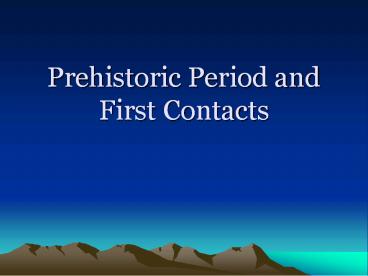Prehistoric Period and First Contacts - PowerPoint PPT Presentation
1 / 34
Title:
Prehistoric Period and First Contacts
Description:
Convert natives to Christianity ... Top 1_Mountain Top Prehistoric Period and First Contacts GPS SS8H1 SS8H1a Paleo Indian Culture PowerPoint Presentation ... – PowerPoint PPT presentation
Number of Views:194
Avg rating:3.0/5.0
Title: Prehistoric Period and First Contacts
1
Prehistoric Period and First Contacts
2
GPS SS8H1
- The student will evaluate the development of
Native American Cultures and the impact of
European exploration and settlement on the Native
American cultures in Georgia.
3
SS8H1a
- Describe the evolution of Native American
cultures (Paleo, Archaic, Woodland, and
Mississippian) prior to European contact.
4
Paleo Indian Culture
5
(No Transcript)
6
(No Transcript)
7
(No Transcript)
8
Paleo Indian Culture
Years 12,000 to 8000 B.C. (BCE)
Social Groupings Nomadic, small groups (i.e. 25) Buried dead with artifacts
Shelter/ Homes Caves, Animal Hides
Weapons/ Tools Spears (Clovis points), Atlatl
Food Bison, Mammoth, Giants Sloths
9
Archaic Indian Culture
10
(No Transcript)
11
(No Transcript)
12
Archaic Indian Culture
Years 8000 to 1000 B.C. (BCE) (Late Archaic around 2500 B.Cpottery)
Social Groupings Camps, Clans (100 to 200)
Shelter/ Homes Crude shelters, stayed in one place longer
Weapons/ Tools Atlatl and spear Drills, bones, needles, hooks
Food Deer, rabbits, seafood, fish Wild berries, grains and fruit
13
Woodland Indian Culture
14
(No Transcript)
15
(No Transcript)
16
(No Transcript)
17
(No Transcript)
18
(No Transcript)
19
Woodland Era Indian Culture
Years 1000 B.C. to 800 A.D.
Social Groupings Tribes, villages with defense perimeters
Shelters/ Homes Permanent domed huts with grass roofs, burial mounds
Weapons/ Tools Bow and Arrow, axes, flint Pottery
Foods Gardening of small plants, such as sunflowers, pumpkins, squash, etc. Small game
20
Mississippian Indian Culture
21
(No Transcript)
22
(No Transcript)
23
(No Transcript)
24
Mississippian Indian Culture
Years 900 A.D. to 1600 A.D.
Social Groupings Tribal councils in earth lodges, High Priest and/or chief lives on highest mound Social classes and division of labor
Shelters/ Homes Large Communities (2,000) with plaza in center and Temple (ceremonial) Mounds Homes same as Woodland period
Weapons/ Tools Bow and Arrow stone axes and farming tools cooper headdresses
Food Intensive farming (maize, beans, squash, and pumpkins), small game
25
(No Transcript)
26
Make three columns and identify some of the
elements of Creek and Cherokee culture (use pages
84 to 91 in Textbook as resource)
Creeks Cherokees
Meaning of name
Location
Tribal government
Villages
Homes/Family
Livelihood
27
- SS8H1b Evaluate the impact of European contact
on Native American cultures including the Spanish
missions along the Barrier Islands, and the
exploration of De Soto - SS8H1c Explain reasons for European exploration
and settlement in North America, with emphasis on
the interests of the French, Spanish, and English
in the southeastern area.
28
First Explorer in Georgia
29
The Spanish
- Founded St. Augustine in 1565
- First Spanish mission in 1566 on St. Catherines
Island - Missions covered area along the barrier islands
and coastal plain called Guale (named after one
of the local tribes) - Purposes
- a. Convert natives to Christianity
- b. Assimilate tribesmen
- c. Physical presence against French and
English
30
(No Transcript)
31
V. Decline of Spanish missions
- Diseases and overworked men
- Slave-raids by British and allies (Yamasee who
later work with Georgia colony) - Spanish Empire losing world power after Spanish
Armada in 1588. - Last mission remained until 1684
32
The French
- Founded Fort Caroline at mouth of St. Johns
River (near Jacksonville) - Wanted base to battle Spanish for control of
southeast and steal gold - Spanish captured fort and drove out French
- French remain in Mississippi River and New Orleans
33
The English
- Reasons for exploring
- and settling the southeastern area
- a. Overcrowding in England
- b. Compete with Spanish and French
- c. Religious freedom
- d. Economic opportunities
34
- Jamestown started in 1607
- Carolina colony founded in 1670 (built Charleston
in 1670) - Ocmulgee trading post (located by the mounds)
founded in 1690. - a. 1703 Col. James Moore and Creek
warriors devastated the Spanish mission system - b. 1715 Yamassee War, 90 of the English
traders were killed. - c. British and Creeks defeat and push
Yamassees back to Florida - V. 1721 to 1728 Fort King George was built at
mouth of Altamaha River (buffer against Spanish)































